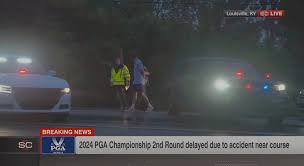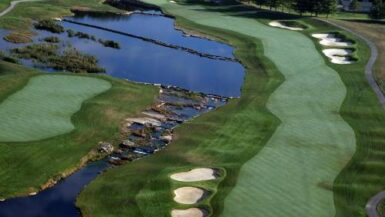Now that Winged Foot has been selected to host the 2020 U.S. Open, can an announcement that Oakland Hills will return to the informal U.S. Open rota be far behind?
We reported hints that Oakland Hills could return here and at Cybergolof. The South Course, famously dubbed “The Monster” in 1951, will host the 2016 U.S. Amateur, often seen as a gateway tournament to hosting a U.S. Open. Similarly, Chambers Bay hosted the 2010 U.S. Amateur as a prelude to their 2015 Open date. Winged Foot and Oakmont also both hosted U.S. Amateurs shortly before their last U.S. Opens in 2006 and 2007.
In 1951, Robert Trent Jones, Sr. made Oakland Hills the birthplace of target golf – “Double target golf actually,” explained his son Bobby, also one of the quintessential golf course architects of his age. The next major the club hosts will be it’s 10th. Through the ages, it has presided over six U.S. Opens, (the last being Steve Jones’s win in 1996), and three PGA Championships, (the latest being Padraig Harrington’s sparkling 66-66 36-hole Sunday finish in 2008 to race past Sergio Garcia and Ben Curtis and claim back-to-back majors and three in his last six. Harrington had repeated as British Open champion at Royal Birkdale three weeks earlier. Several other Hall of Famers have won at Oakland Hills as well, including Ralph Guldahl in 1937 who shot 69 on the final day to shock a broken-hearted Sam Snead, (Snead had been accepting congratulations from tournament officials and journalists alike, before Guldahl raced past him at the end). Gene Littler and Gary Player also won a U.S. Open and PGA Championship in 1961 and 1972 respectively.
Oakland Hills has also seen its share of fluke winners. Besides Jones – seeing him hoist the Wanamaker Trophy was like seeing a shark on a mountaintop – Cyril Walker, David Graham, and Andy North also won majors here.
Referring to North’s bolt from the blue, zany victory, Fox Sports Broadcaster Steve Czaban said, “the entire 1985 U.S. Open should be stricken from the record books completely,” as a statistical outlier and a deadly bore. Unknown Taiwanese player T.C. Chen not only led the Open for three days, but was running away with it before taking the now infamous quadruple-bogey 8, where he double hit a greenside chip for a two-stroke penalty. His four shot lead vanished in a heartbeat like a rabbit in a conjuring trick. Andy North, who won a grand total of three tournaments in his life, but two U.S. Opens, held off Chen – now known forever as “Two-Chip” instead of “Tse-Chung” – and a bunch of career bit players like Dave Barr and Denis Watson.
“I wouldn’t ask those guys to wash my car,” Czaban fulminated. The real star that year was the golf course, which confounded everyone by playing harder than the previous years’ opens at Winged Foot, Oakmont, Pebble Beach, Merion, Baltusrol, Inverness, and Cherry Hill respectively. Even par was the winning score.
The spine, heart, and central nervous system of the course are its severely undulating greens, brilliantly serpentine routing, and heaving terrain, which are still essentially the same as Donald Ross built in 1917. Only the fairway bunkering has been consistently rebuilt through the decades to offset advances in driving distances, first by Trent, then by his other son, Rees. Ross’s greens are just as murderous and unpredictable as Oakmont and equally fast.
“If you gave Oakland Hills three weeks to prepare, it could easily be ready to host a major championship in case of emergency,” said six time major champion Lee Trevino in an interview with your wuthor from some years ago.
“The greens have a lot of movement and have some tough pin positions,” agreed Sergio Garcia. “Some greens, like 18, are very wide but are divided into sections so that your real target is much smaller.”
“It’s one of those old Donald Ross courses with fantastic greens that require shotmaking. I love it here” said Jay Haas, a grizzled, wily veteran who been highly successful on the champions Tour after a competitive PGA TOUR career. “Next to Winged Foot, it’s my favorite course. Winged Foot may be number 1 to me, but Oakland Hills and Oakmont are 1A,” he finished energetically. “It’s tough, but it’s fair.”
As such, the South course will make a sterling venue, and a great return to the U.S. Open rotation. It’s a mid-west venue, and the U.S.G.A. has needed a great breadbasket/rust belt course for many years now. It’s a classic Golden age course, with a venerable history, outstanding greens, and plenty of difficulty without having to be tricked up with needless rough. And it’s got plenty of room for all the hoopla associated with hosting perhaps the largest golf tournament in the World.
Matter of Interest: According to legend Hogan supposedly said, “I’m glad I could bring this Monster to its knees, but according to Golf Digest writer Dan Jenkins, (who was there), Hogan actually said “this ______”, (something unprintable), and Jenkins and the boys simply substituted “Monster,” so the moniker may be Jenkins’s after all. See Dan’s book “Jenkins at the Majors” for more details.





